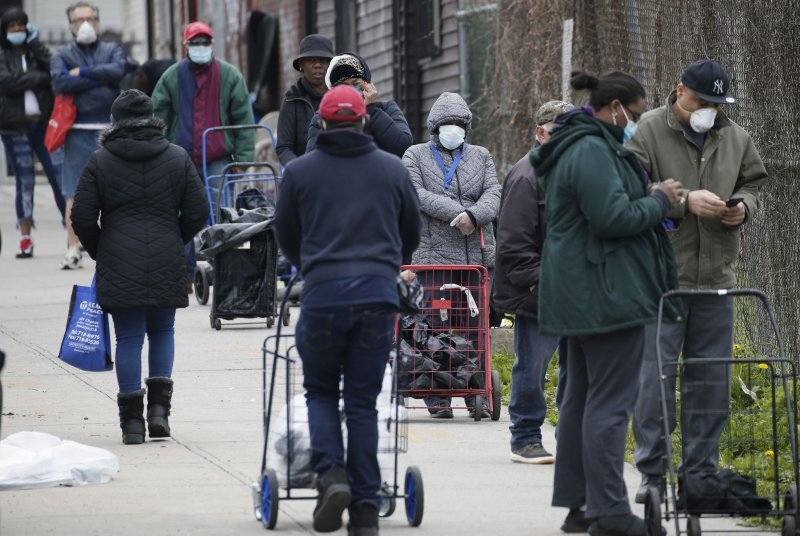People wait on line for food in New York City in April 2020. The advance Child Tax Credit provision of the American Rescue Plan reduced food insufficiency in households with children by 26%, according to a new analysis. File photo by John Angelillo/UPI |
License Photo
Jan. 13 (UPI) -- Advance Child Tax Credit payments, part of last year's federal American Rescue Plan, reduced food insufficiency, or lack of food, in households across the country by 26%, a study published Thursday by JAMA Network Open found.
However, those gains are likely to be reversed because the federal relief package expired at the end of 2021, the researchers said.
An extension of the program was included in the Build Back Better Act, but Congress has failed to pass the bill.
"Not having enough food is just one dimension of poverty and hardship that families face, and hunger has significant costs to our health and society that are absolutely avoidable," study co-author Paul Shafer said in a press release.
"Hopefully our work puts more pressure on policymakers to keep working and to find a package, incorporating the Child Tax Credit, that can pass," said Shafer, assistant professor of health law, policy and management at Boston University School of Public Health.
Up to 45 million people in the United States experience food insecurity, or lack of access to needed food, based on recent estimates.
Food insufficiency is a formal measure of hunger defined as conditions in which a household lacks enough food to eat, according to the Food Research and Action Center, a non-profit research and advocacy organization that focuses on hunger and under-nutrition.
Under the American Rescue Plan, passed by Congress in March of last year to provide financial relief during the COVID-19 pandemic, families that earn less than $150,000 per year qualified for an increased Child Tax Credit for everyone who was under age 18 years living in the household at the end of last year.
The advance Child Tax Credit provision raised the credit, per child, to $3,600 per year from $2,000, and distributed half in the form of monthly payments that ranged from $250 to $300.
Eligible recipients can claim the remainder of the tax credit when they file their 2021 income tax returns, the IRS says.
This additional economic support raised 3.5 million children out of poverty, according to the Center on Poverty and Social Policy at Columbia University in New York City.
For this study, Shafer and his colleagues analyzed 585,170 responses to a national survey on food insufficiency among households with children in the United States between Jan. 6 and Aug. 2 last year.
Based on the responses, which represented more than 77,000 households, food insufficiency declined more than twice as much among households with children than it did among those without children following the first advance Child Tax Credit payment, the researchers said.
Among households with children, food insufficiency declined to 12% from 22% among Hispanic American households while it dropped to 21% from 22% among Black American households.
"The advance Child Tax Credit provides a historic opportunity to alleviate long-standing inequities in food insecurity," study co-author Stephanie Ettinger de Cuba said in a press release.
"Allowing this evidence-based policy to expire will not only push millions of children back into hardship, but it threatens the health and economic stability of children," said Ettinger de Cuba, executive director of Children's HealthWatch, a network of pediatricians and child advocates.















